Step up your pizza game by making Sourdough Pizza Dough! This recipe is made with bread flour, a touch of whole wheat flour and an active Sourdough Bread Starter. After a long overnight rise, the dough can be proofed at room temperature or in the refrigerator for longer storage. This recipe is vegetarian and vegan friendly.
Looking for a same-day sourdough pizza recipe? Try my Sourdough Discard Pizza Dough recipe that doesn’t compromise on texture or flavor! [ how to shape sourdough pizza VIDEO below ]
⭐️⭐️⭐️⭐️⭐️ Review: “The absolute best pizza dough out there. We have made it twice and both times it was both delicious and easy to handle.” ~ Santina
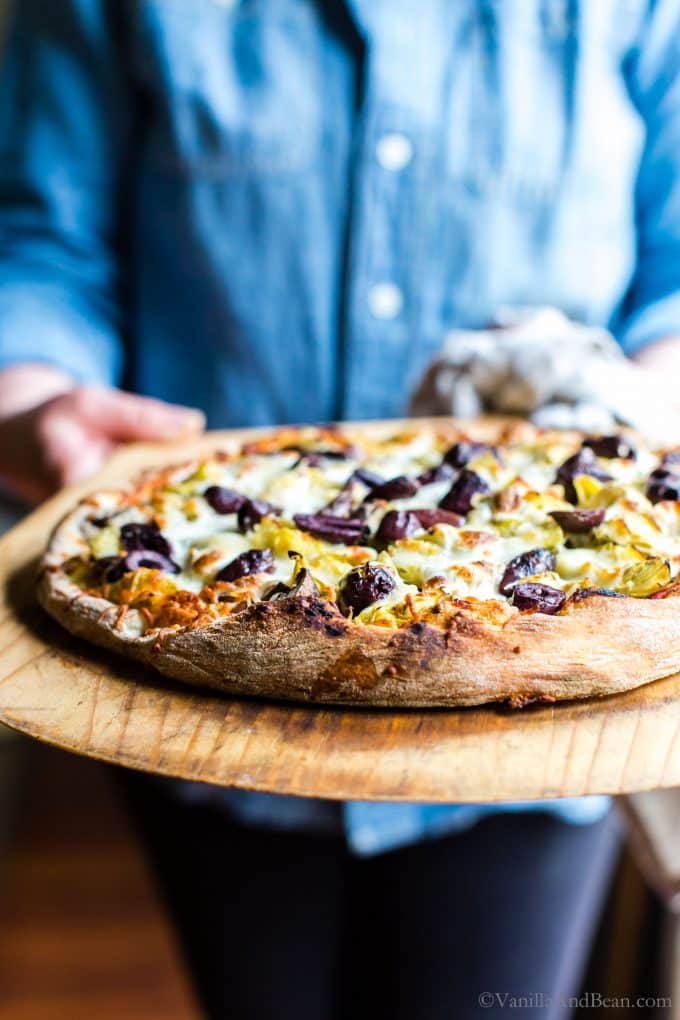
Table of Contents
Sourdough Starter Pizza Dough
Are you ready for a game changer in homemade pizza? If you love the taste homemade Sourdough Recipes you’re going to love this sourdough pizza crust recipe. A weekend tradition, this flavorful, chewy, slightly crispy, and satisfying sourdough pizza is something we look forward to on the weekends.
Like Multigrain Sourdough Bread or Maple Oat Sourdough Sandwich Bread, making from scratch pizza really doesn’t require that much hands on time. You’ll think about it more than the time it takes to make it.
And although this sourdough pizza crust recipe looks like there’s SO much to the process, once you get the routine down, you’ll discover how simple making sourdough pizza dough really is.
Example Baker’s Schedule for this Sourdough Pizza Recipe
- Thursday Night: Mix the Dough – Ferment Overnight at Room Temperature
- Friday Morning: Shape the Dough into Little Dough Balls – Pop it in the Refrigerator to Start Proofing
- Friday Afternoon: Pull the Sourdough Pizza Dough From the Refrigerator – Finish Proofing at Room Temperature for about 2-3 Hours.
- Friday Night: Shape and Bake!
In this recipe, I’m sharing my tips, pizza making tools, a few different flour varieties to choose from and my favorite toppings. So get ready! Let’s make homemade sourdough starter pizza dough!
Need a sourdough starter? Follow my DIY Sourdough Starter recipe.
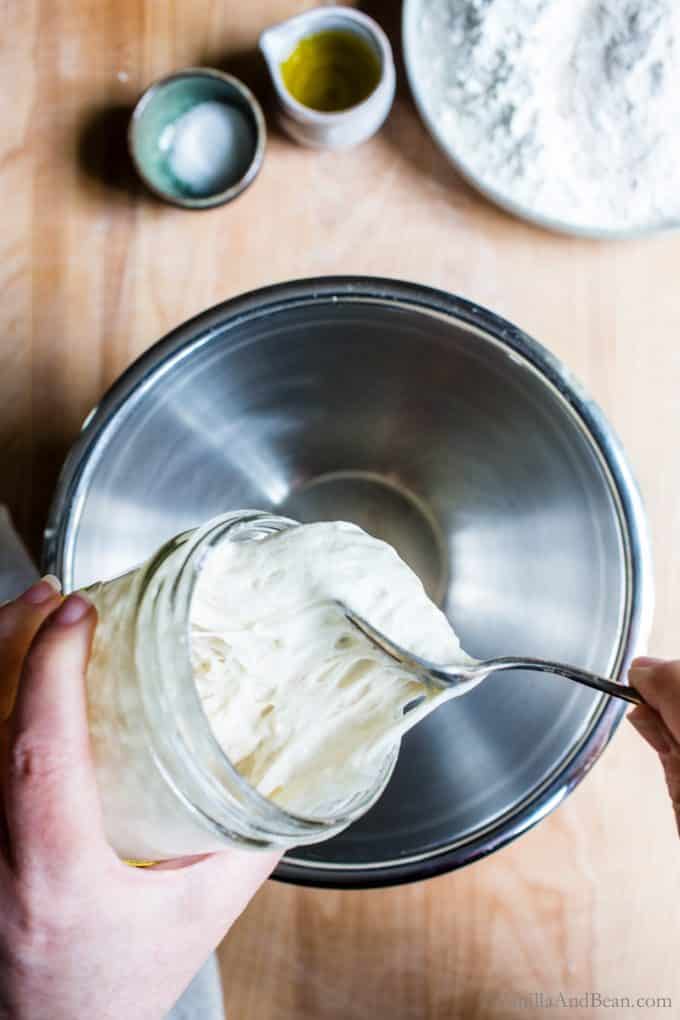
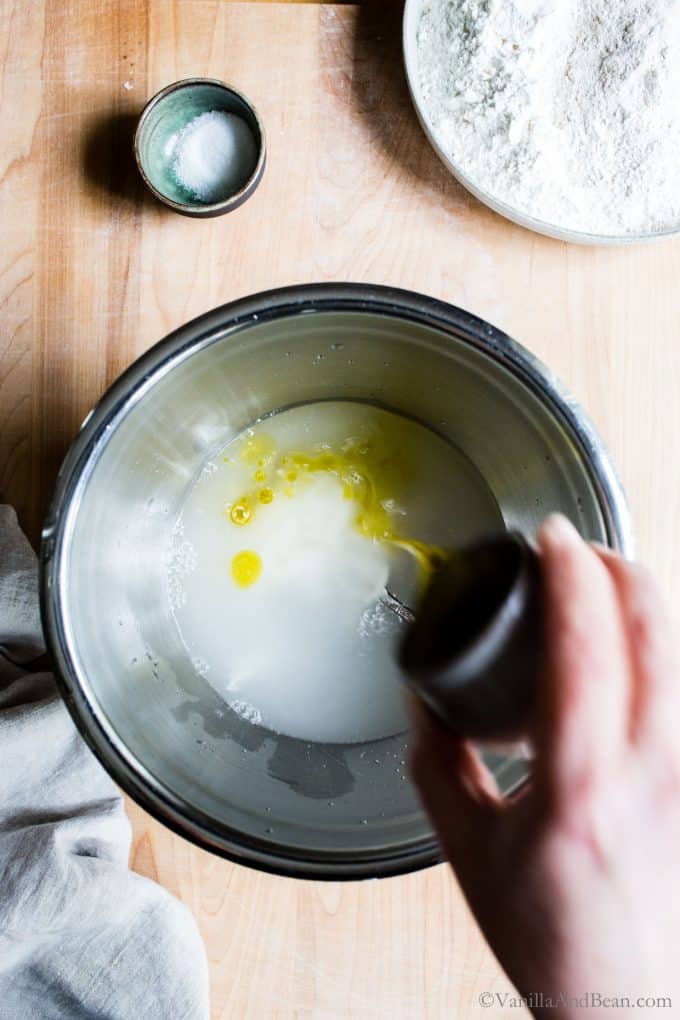
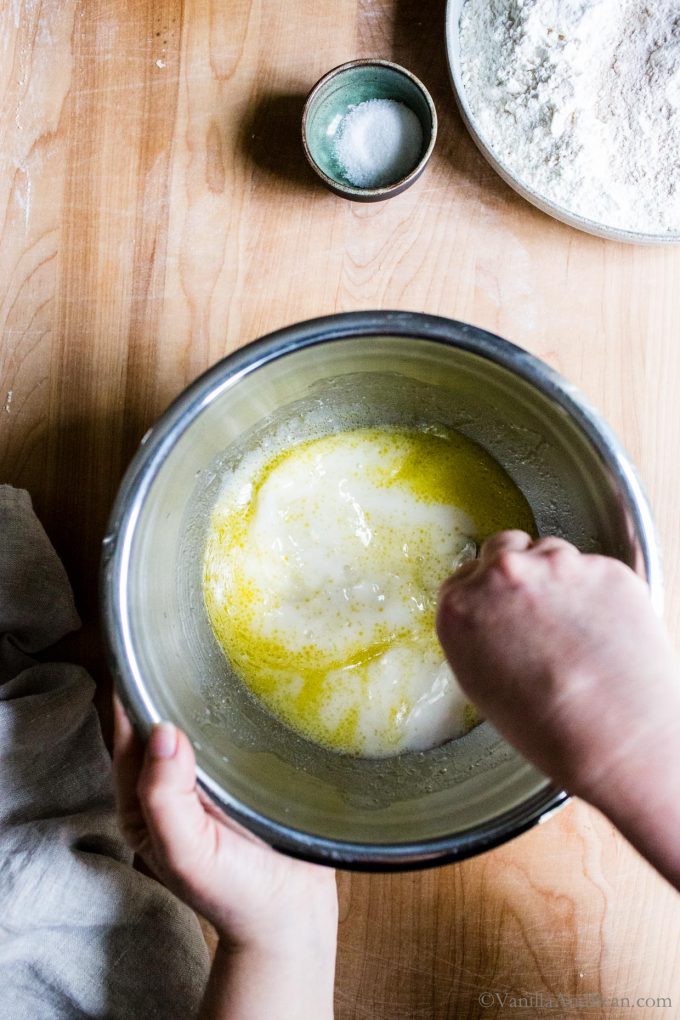
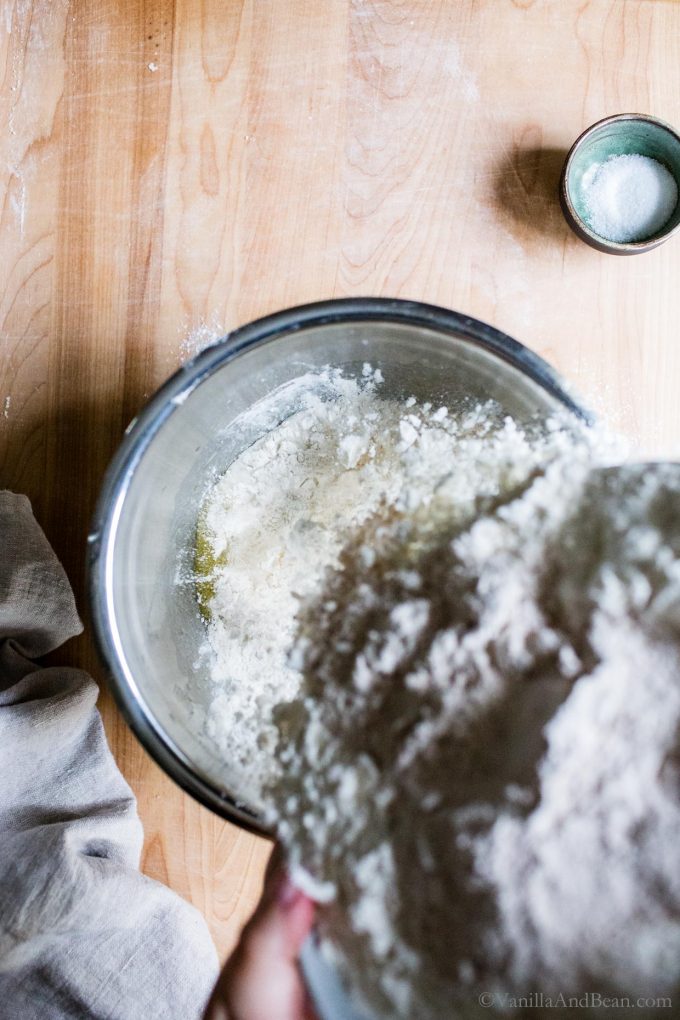
The Start of Something Delicious
For this sourdough pizza dough recipe, start with five simple ingredients and a mixing bowl. Here’s what you’ll need (see recipe card for details):
- Sourdough Starter – fed, doubled in size, ripe, and bubbly. Try my Sourdough Bread Starter to make one.
- Water – I use tap, but if you like, you can use filtered.
- Olive Oil – use a full bodied olive oil here for flavor. It also tenderizes the dough!
- Flour – I like a mix of whole wheat and bread flour, but you can also use all, all purpose or all bread flour.
- Fine Sea Salt
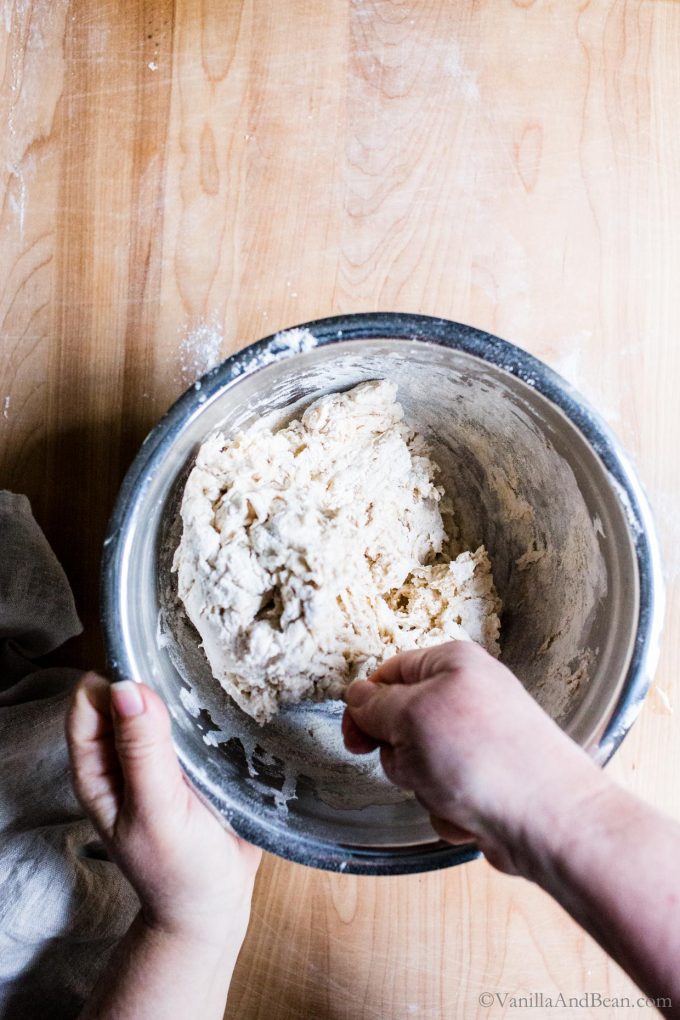
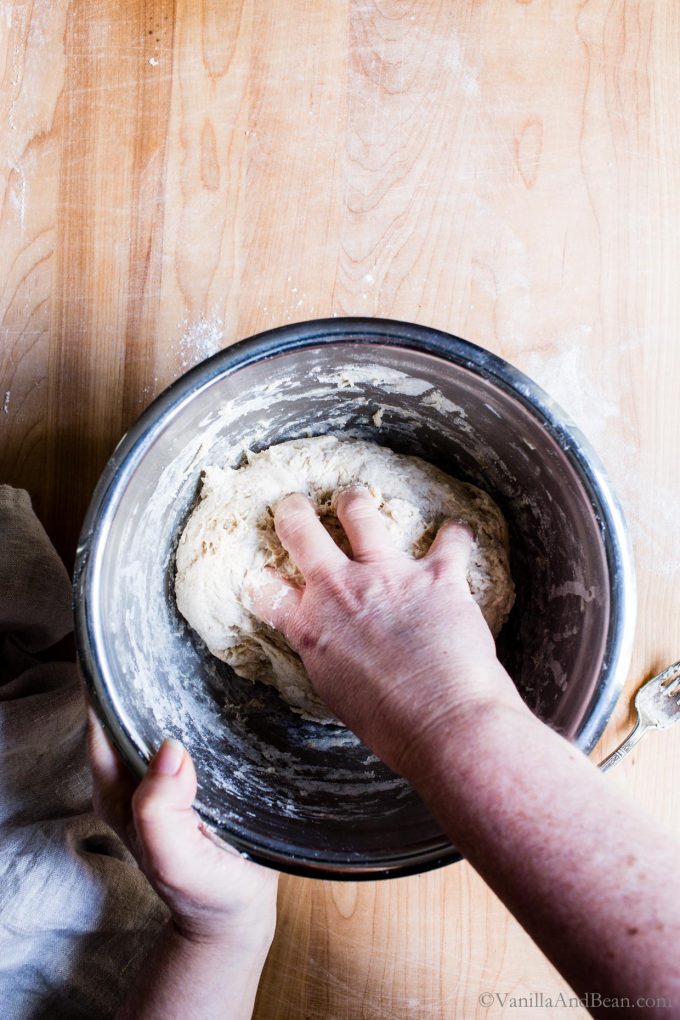
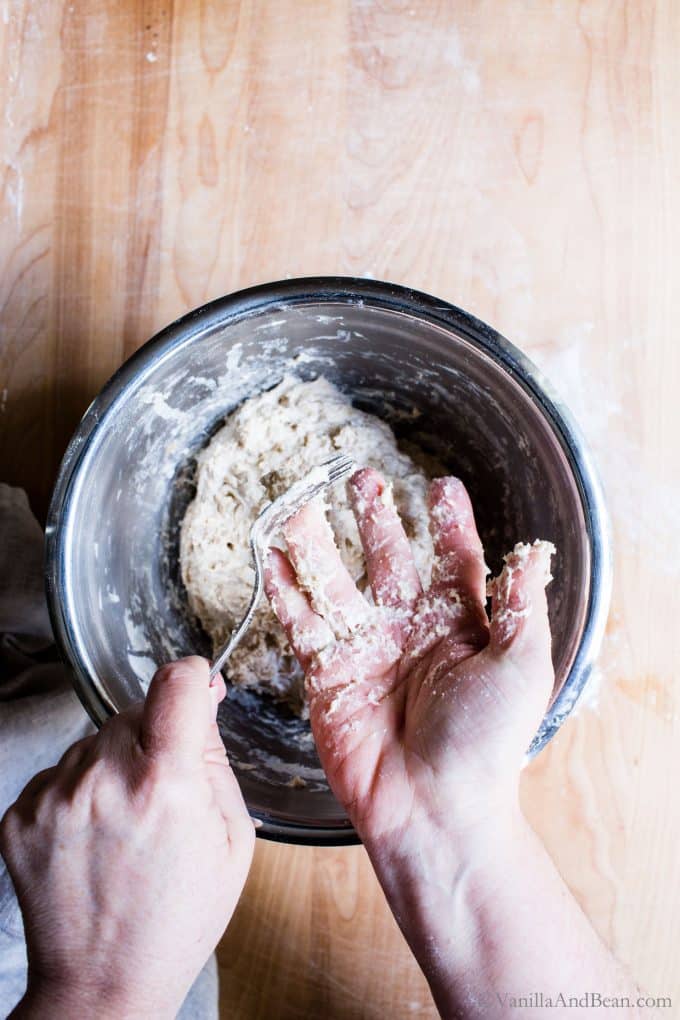
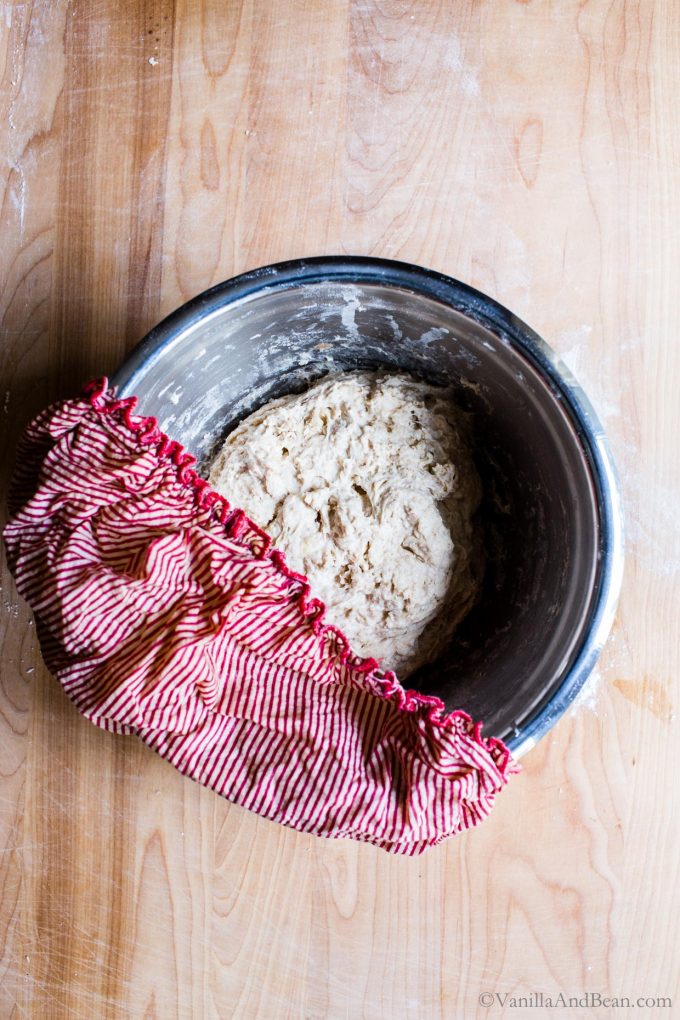
Quick Mix Guide: How to Make Sourdough Starter Pizza Dough
- First, you’ll mix the starter with water, then add the olive oil, using a fork to combine.
- Second, add the flour.
- Third, use a fork to incorporate the ingredients. Switch to kneading with your hand, The dough will feel stiff and sticky at this point. Rest the dough.
- Fourth, once the initial rest is done, fold the dough. This term simply means to take a portion of your dough, gently stretch it and press it down towards the center of the dough. Repeat this process until you work all the way around the dough.
- Fifth, at this point you can cover your dough with a damp tea towel and leave it to bulk ferment or you can do up to two more folds over the next hour. Performing folds builds strength and structure and improves the overall quality of your dough.
Make this sourdough pizza recipe fit your schedule. Fold or not, you’ll still have a fabulous sourdough pizza either way! Now you’re ready for the bulk rise…
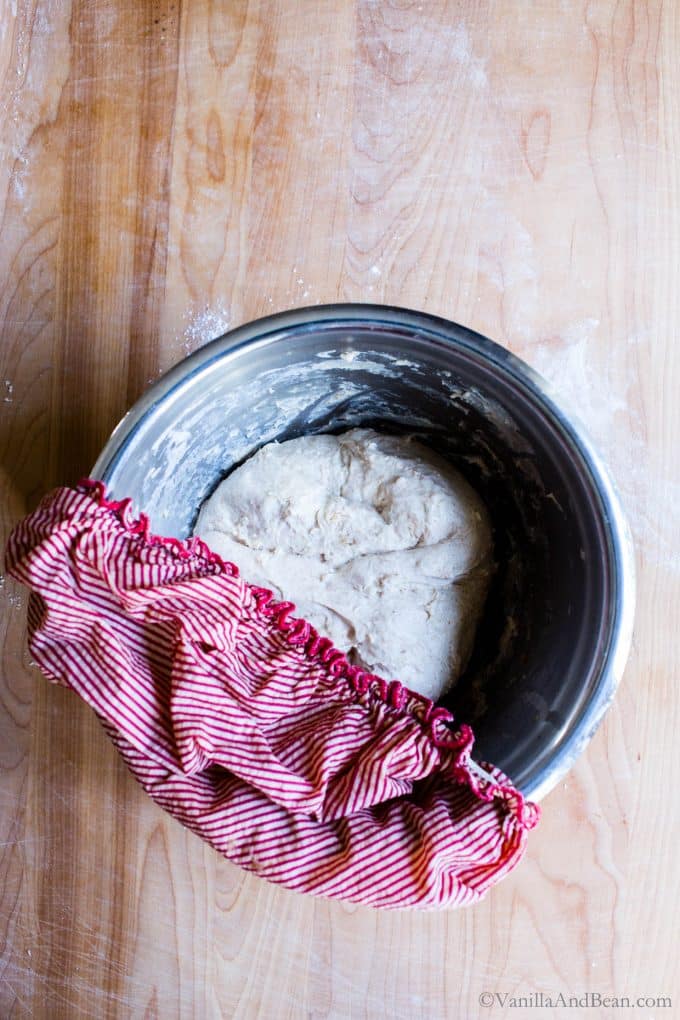
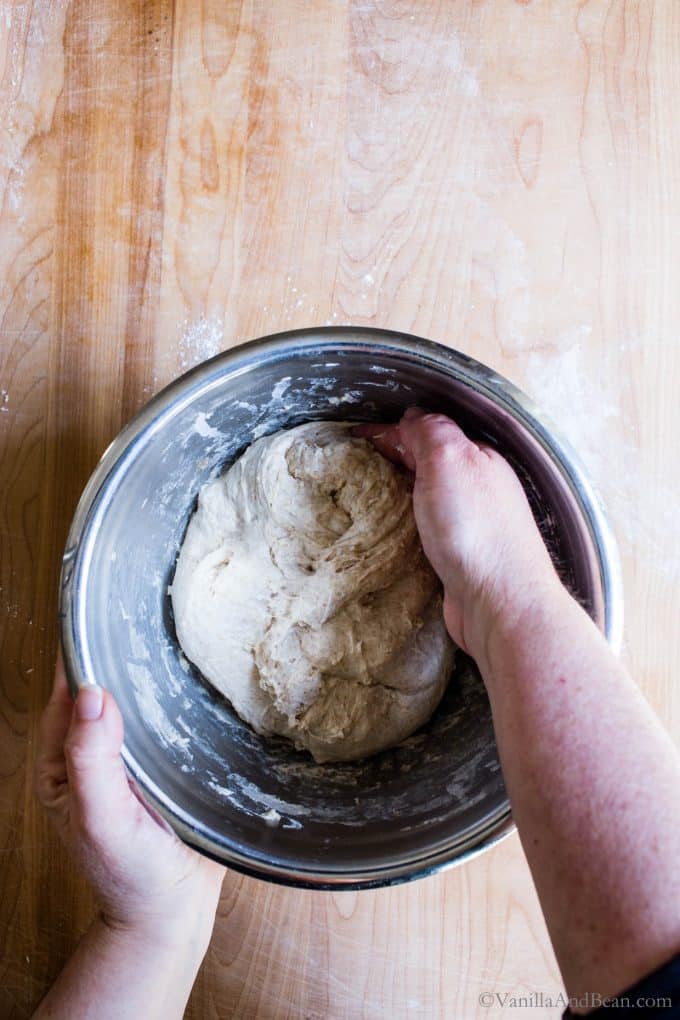
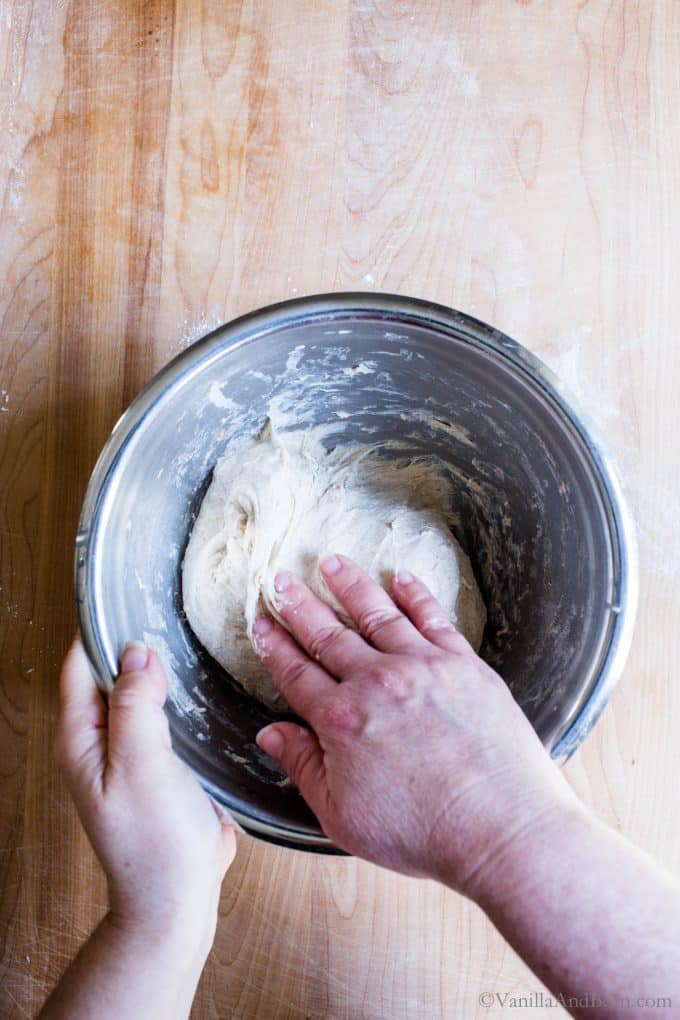
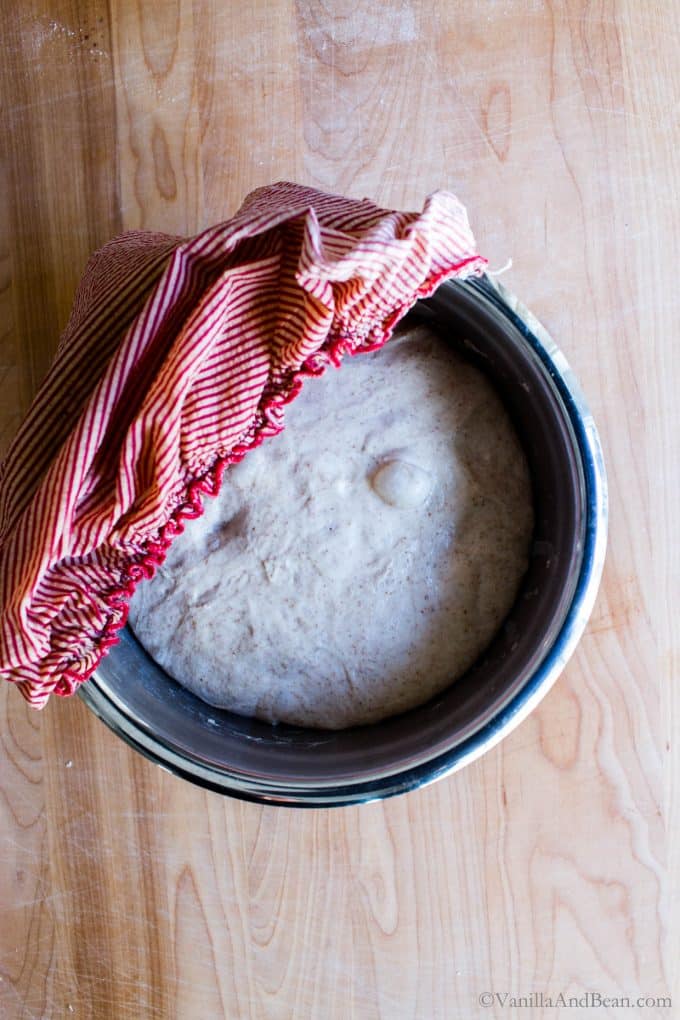
Bulk Fermentation (first rise)
This step shouldn’t be rushed, because this is when most of the flavor development happens.
TIME = FLAVOR
At this point the dough is rested at room temperature until it doubles in size, is jiggly and no longer feels dense. At 70F (21C), this will take anywhere from 8-10 hours. In my cooler kitchen, 65-68F (18-20C), it takes upwards of 12-14 hours. Use this time and temperature as a guide and not a determining factor for when the dough is ready. It’s ready when it’s ready.
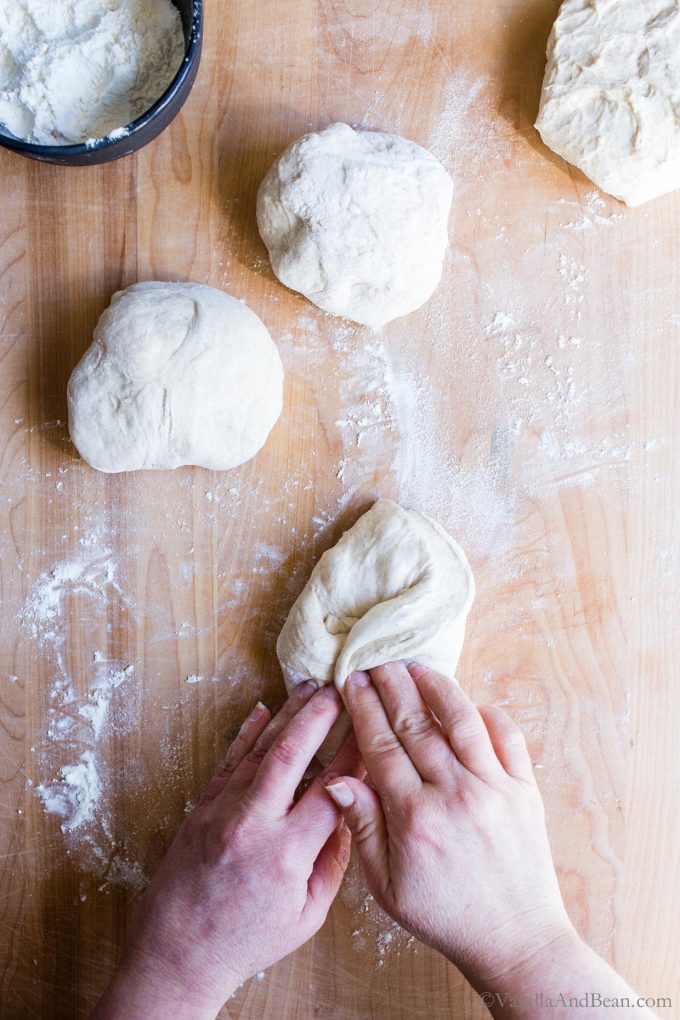
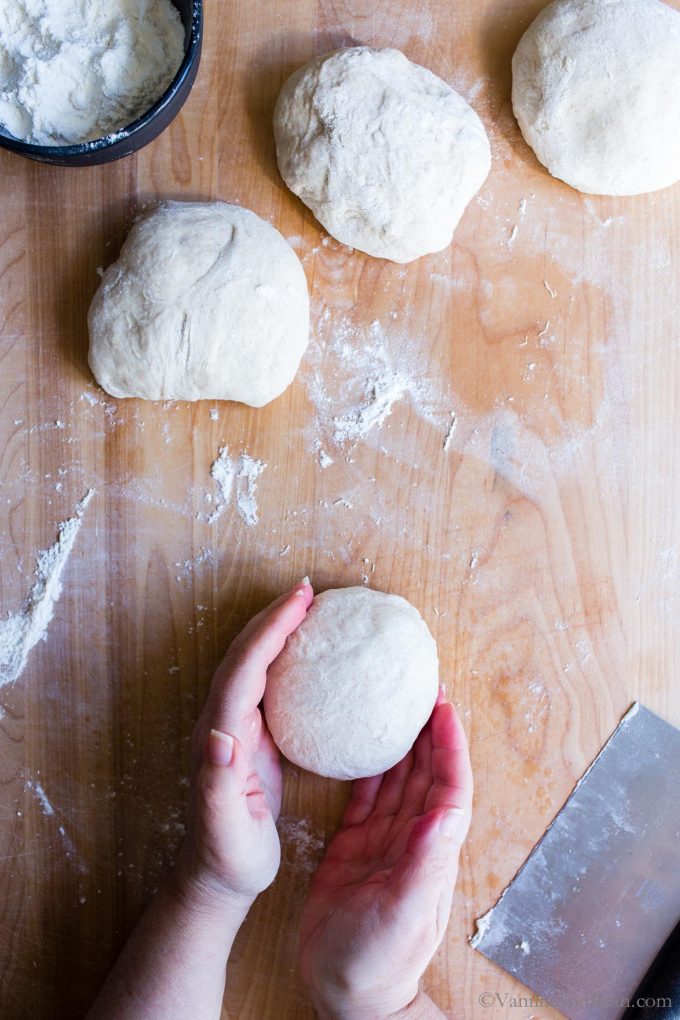
Shape – Rest – Shape
Once the dough has about doubled in size, it’s time to shape the dough. First, you’ll divide dough into equal pieces. Then shape each piece into a rough round by folding each side to the middle, then the top and bottom. Flip the dough over and allow it to rest for about 10 minutes.
This is a good time to prepare your proofing containers. I like to use 4 C (950mL) lidded glass bowls for this. It helps the dough hold it’s shape and they’re reusable. Zip top or reusable food storage bags can be used as well. Simply brush the vessel with olive oil to prevent sticking.
After the rest, you’ll shape the dough into dough balls, making sure the skin/surface is taught and transfer the dough to its proofing container.
How to Freeze Sourdough Starter Pizza Dough (optional)
If you opt to freeze your dough balls, this is the time to do it. Freeze them in zip top bags or in their glass storage containers. When ready to use, thaw them out overnight in the refrigerator, then carry on with proofing the following day. Note that the dough doesn’t quite bake up as beautifully as fresh dough, but freezing is an option. I suggest using frozen dough within a week of freezing.
Got sourdough discard? Use it in these Sourdough Discard Recipes!
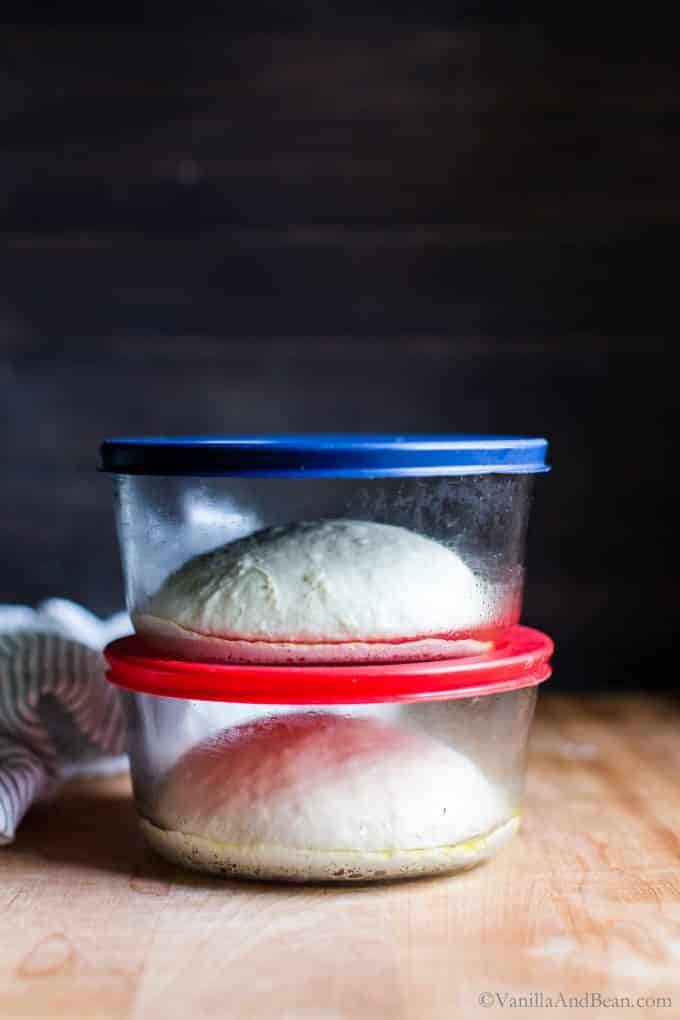
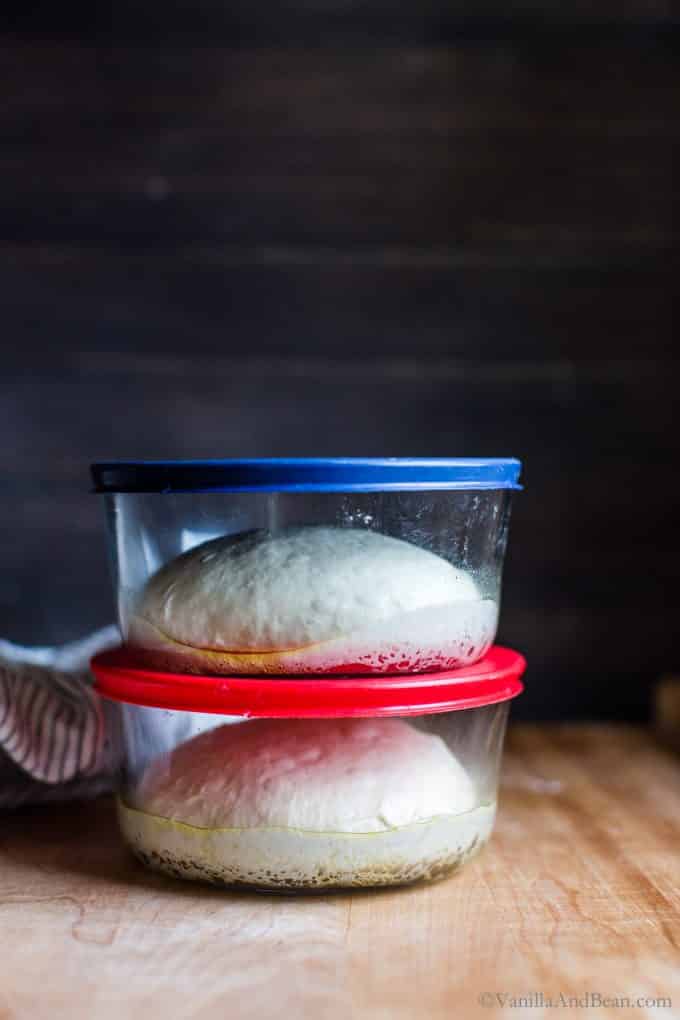
Proof Two Ways (second rise)
After shaping the dough, there are several ways to proof the dough, depending on your schedule:
Refrigerator: After shaping the dough, you can pop it in the fridge for up to two days. It will continue to rise in the refrigerator, just at a slower rate. You’ll need to pull the dough from the fridge about two to three hours before you’re ready to make pizza so it can finish rising and/or warm up to room temperature (this at a room temperature of 65-68F). Trying to shape pizza with cold dough is frustrating, so make sure you give it time to warm up. This is the method I prefer because it works for my schedule.
The first photo above shows the dough just pulled from the fridge after a six hour refrigerator proof. The second image (the same dough), shows the dough after continuing to proof at room temperature for about two and a half hours. The image on the right is fluffy and slightly bubbly – ready for making pizza! You can allow the dough to rise more to fully doubled in size proof for looser/softer shaping.
Room Temperature: If you’re ready to make pizza sooner than later, you can skip refrigeration and proof the dough at room temperature for about one and a half hours (this at a room temperature of 65-68F) right after shaping the dough. The warmer the kitchen, the quicker the rise. Keep an eye on it.
When is the Proofed Sourdough Pizza Dough Ready?
The dough is ready to make pizza when it’s risen between over one and a half times in size to just doubling in size, is puffy and springy to the touch (it’s pretty forgiving – just make sure it’s at room temp).
In a Hurry? I usually don’t advocate for speeding up sourdough, but this is a time where you can. If you want the proof to go a little more quickly, pop the dough balls in the proofing vessel in a turned off oven with the light on. This will speed the process a bit.
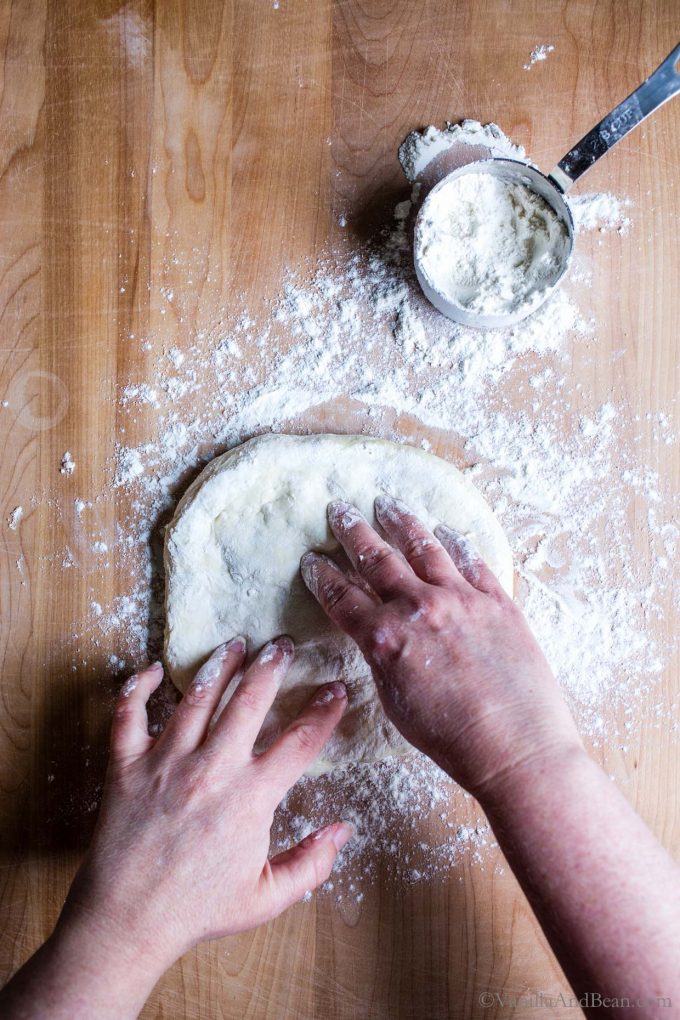
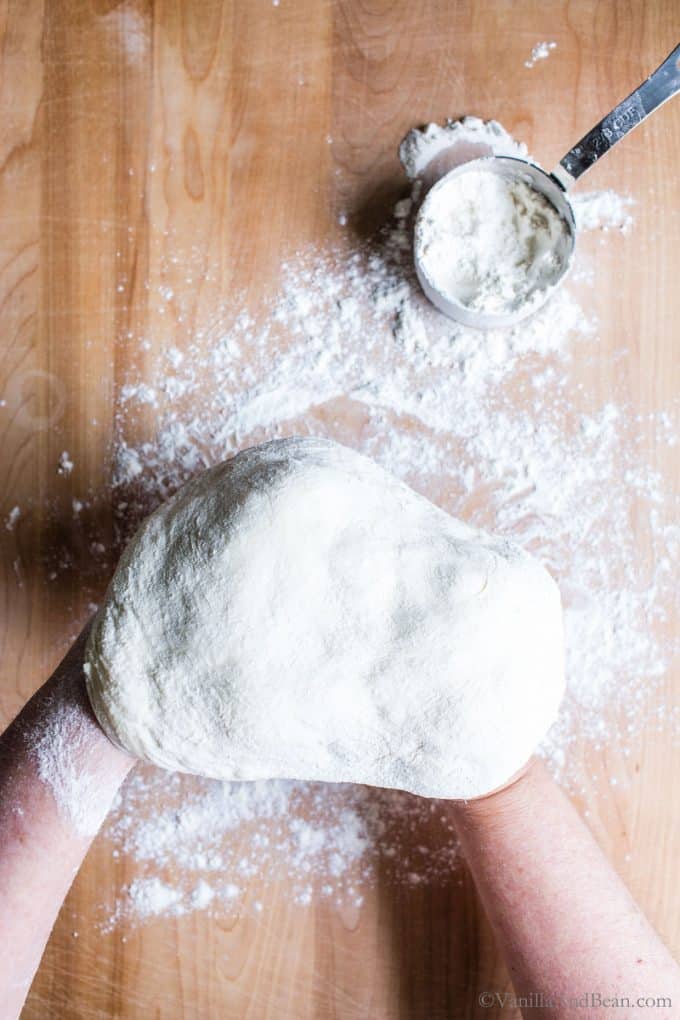
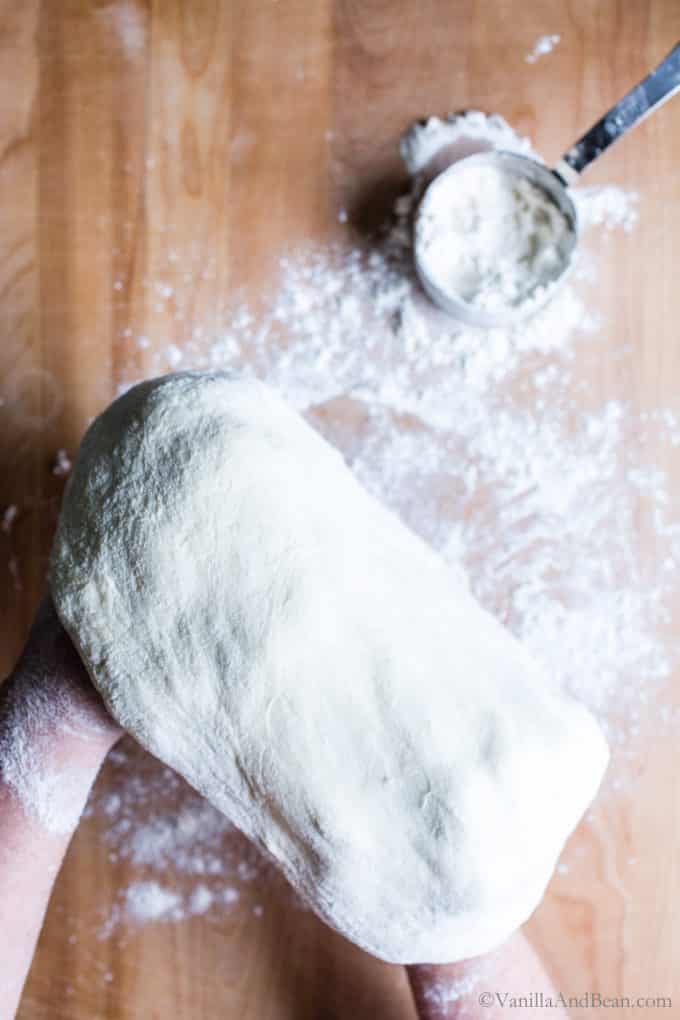
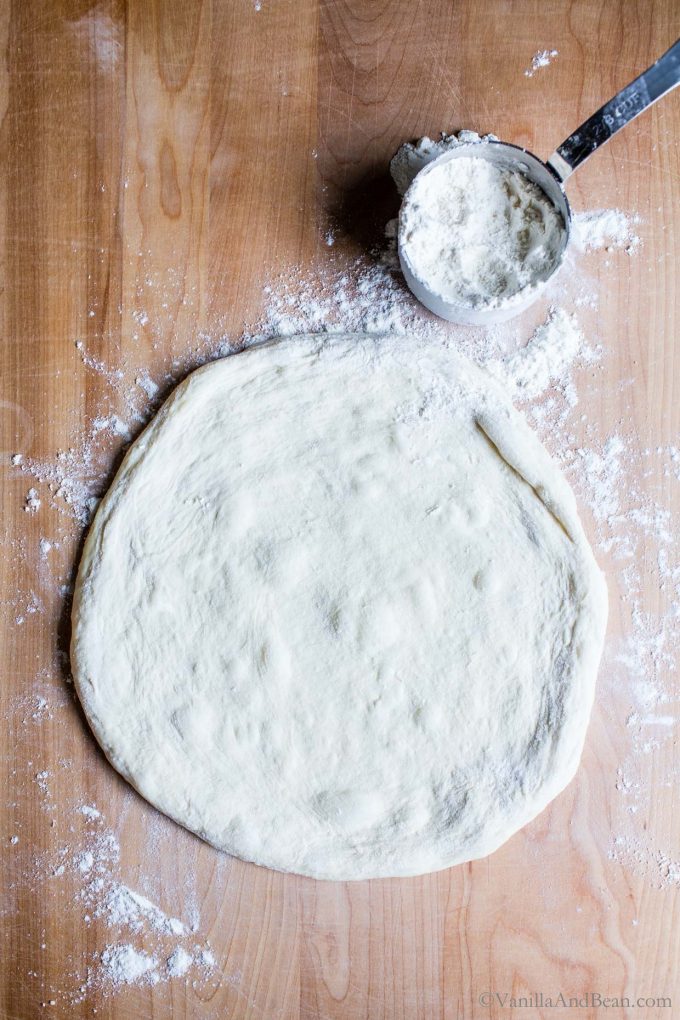
Let’s Make Sourdough Pizza!
Preparing the Oven: Place an oven rack on the second setting from the top. If making a second pizza, set another rack two positions below the top one. You can easily bake two pizzas at a time. Place an upside down sheet pan and/or a pizza stone on a rack, one each if baking two pizzas.
Preheat the Oven & Sheet Pan and/or Pizza Stone: to 550F preferably, or 500F if that is as hot as your oven gets. You’ll want to preheat for at least 45 minutes.
Just before getting ready to shape the dough, and while your oven is preheating, gather and prepare the ingredients, chopping small or slicing thin. When making pizza, less is more for a crisper bottom crust (but don’t look at my pizza below – I pile on the toppings!). You can opt to saute the veggies before putting them on the pizza if you like. I go with raw.
How to Shape Sourdough Pizza Dough Video
Shape the Pizza Dough: Don’t be shy with the flour here! Gently nudge the sourdough pizza dough out of the proofing vessel and onto a floured surface trying to keep it in a round as best you can. Flour the top and edges generously.
Dimple the center of the dough using your finger tips gently pressing down to the surface of the board (think focaccia). Avoid the outer 1/4 inch of the dough ball – this is your crust edge. Pick the dough up and place it on the backs of your fisted and floured hands gently pulling and stretching the dough into a disc. Place back down on your floured surface. Is the shape how you like it? If not give it a few stretches again using the back of your hands until it’s rounded. The pizza should measure about 11 inches (28 centimeters).
If you feel the dough is tight, place it on the board and let it rest for about 5 minutes before you attempt shaping again. It will relax as it sets.
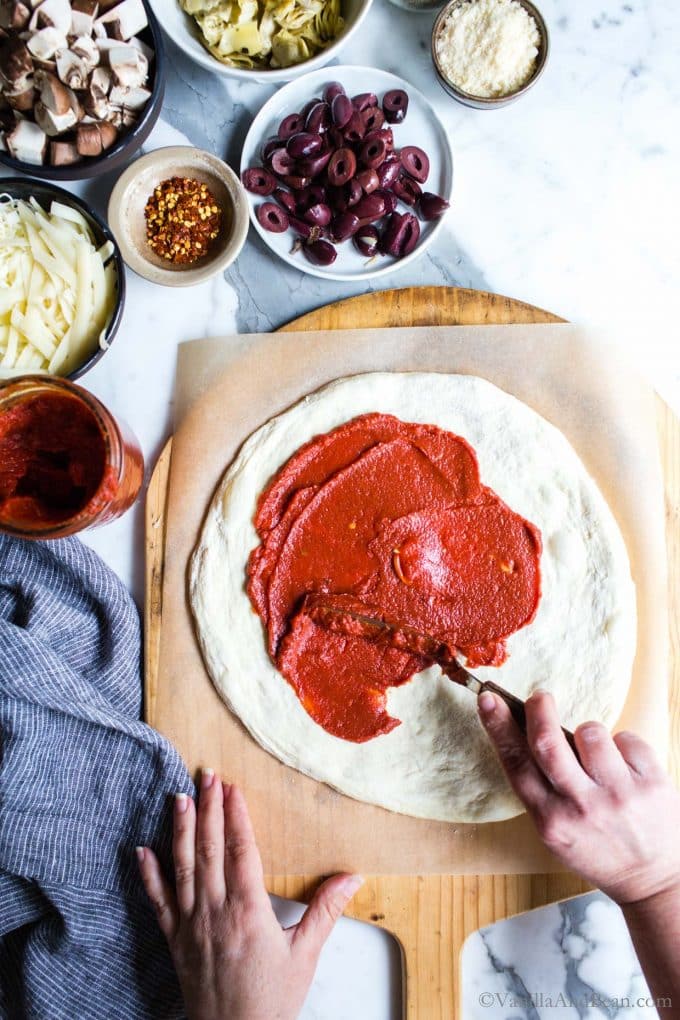
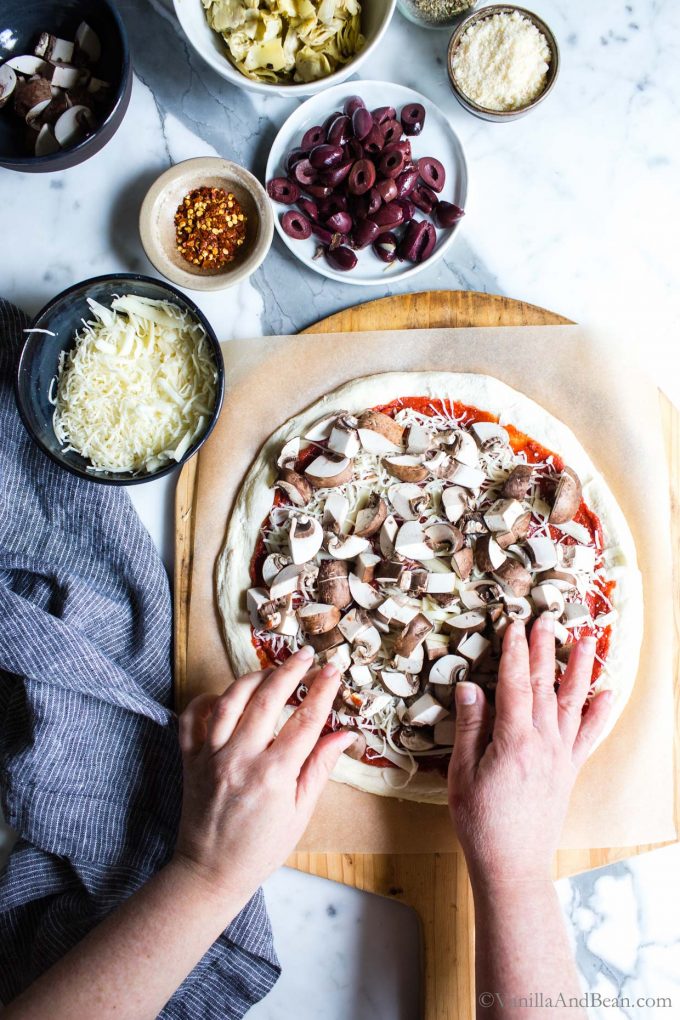
Add the Toppings
Place the shaped dough on a piece of parchment paper. The parchment will be used to transfer the dough onto the preheated pizza stone or sheet pan. Note that parchment paper is generally rated for use under 500F. So at 550F, with any overhang, the paper will char and become brittle. Cooks Illustrated has more on this.
The great thing about pizza is that you can personalize it in so many ways. Let your cravings guide you!
The Sauce: Spread a thin layer of sauce on the pizza. You can opt for a rich and thick homemade red pizza sauce or your favorite marinara right from the jar, your favorite basil pesto or garlic scape pesto or a white sauce. A thin layer will bring out the best potential for the bottom to crisp up.
The Veggies: Less is more when it comes to pizza making depending on how crisp/chewy you prefer the bottom crust to be. I don’t mind if the bottom crust is a bit soft so I pile on the toppings. If you prefer a crisper crust, go light on the sauce and toppings. You can also saute the veggies to bring out even more flavor before topping your pizza. For a home run, try caramelized onions!
For greens like spinach, keep it under the cheese so it doesn’t burn.
The Cheese: A thin layer of cheese on top of the sauce is a delicious way to add layers to the pizza. I like fresh shredded parmesan. Then, after the veggies and for the top, try at least three or more varieties of cheeses. My favorites include shredded Italian blend, shredded mozzarella, fresh mozzarella and/or feta.
Top the Cheese: Before baking, top the pizza with olives and dried Italian herbs. Fresh basil can go on top after baking.
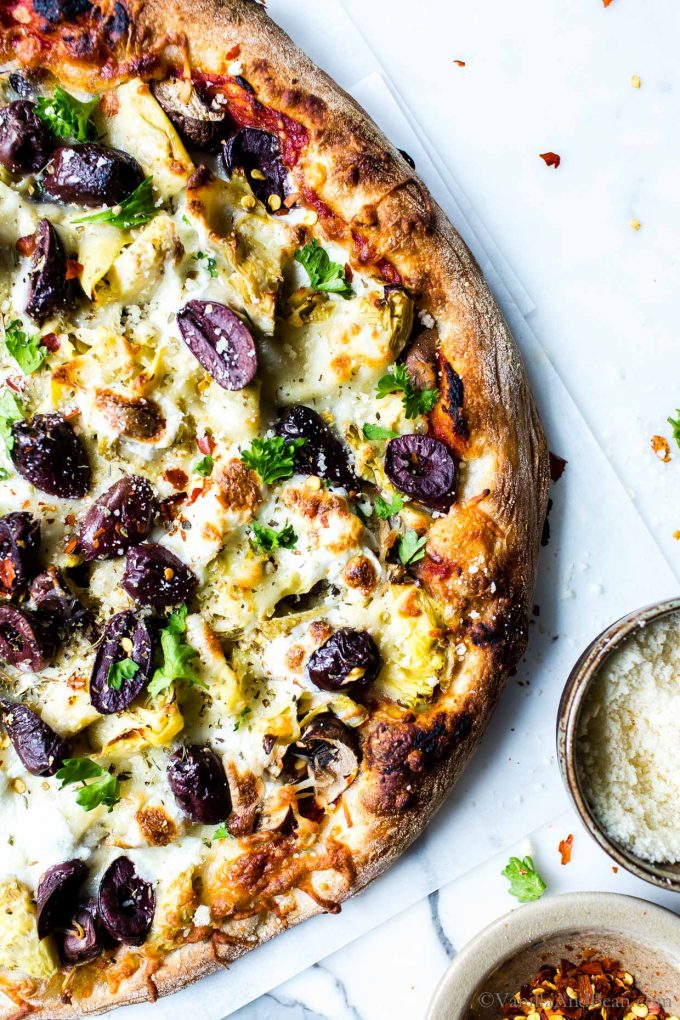

Bake the Sourdough Pizza
Once you’re ready to bake your sourdough pizza, transfer the pizza to a pizza peel or back of a sheet pan. Trim the parchment so that it’s just flush with the pizza dough leaving a bit of overhang to use as a handle if needed. Slide the pizza off the peel or back of a sheet pan and onto the preheated stone/pan. Be careful, the oven is HOT!
Bake the pizza for about 7-9 minutes, or until the cheese is melty and the crust is golden with some charring. It bakes fast, so keep an eye on it! Use the peel or back of a sheet pan to remove the pizza from the oven and transfer to a cutting board.
Allow the pizza to rest for about five minutes before cutting into it. Your sourdough pizza is ready!
If you like condiments for your pizza, you’ll love, Pickled Jalapeno Peppers or Pickled Banana Peppers for added spice and Greek Yogurt Ranch Dressing or Dairy Free Ranch Dressing for dipping.
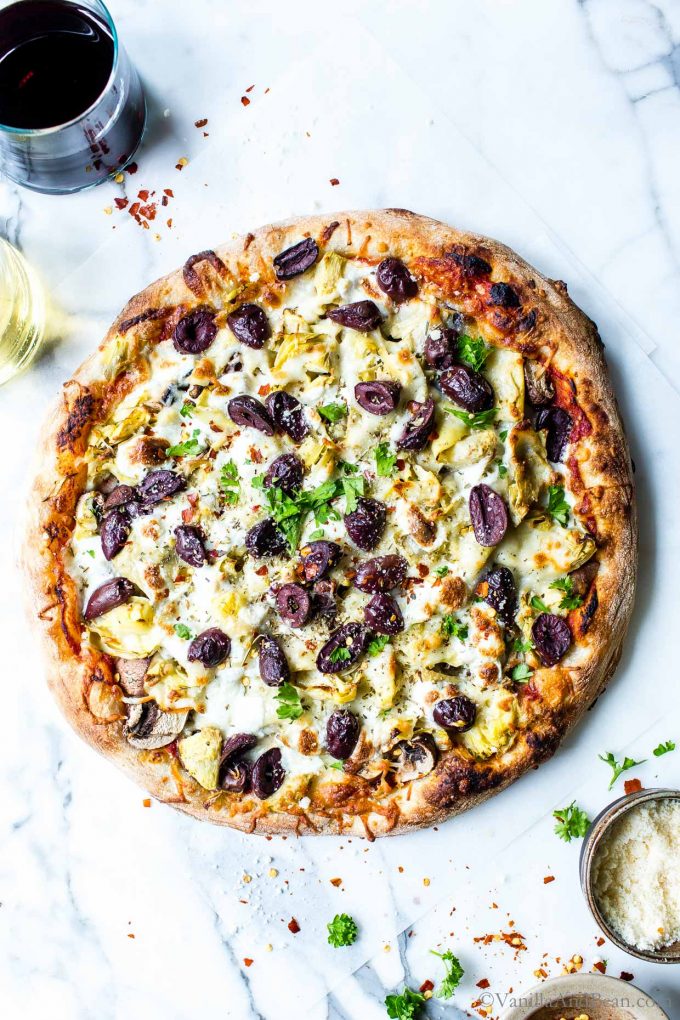
Expert Tips
- Note that parchment paper is generally rated for use under 500F. So at 550F, with any overhang, beyond the sourdough pizza dough, the paper will char and become brittle. Cooks Illustrated has more on this.
- Timing: Use the times mentioned in the recipe as a guide rather than a determining factor for when the sourdough pizza dough is done fermenting and proofing. The ambient temperature and how active your starter is will determine when the dough is ready. It’s ready when it’s ready.
- You’ll love the flexibility of this sourdough pizza crust recipe.
- As written, this sourdough pizza dough recipe produces a soft, chewy crust with crispy edges. For a crisper crust, you can reduce the water just a bit. A few Tablespoons makes a difference. Play with the hydration until you find your pizza bliss!
- Because moisture content can vary from one bag of flour to another and also due to humidity variations in the environment, feel free to adjust the water content one teaspoon at a time if the dough feels too dry during mixing.
- Use all, all purpose or bread flour or mix in a bit of whole wheat flour for a more rustic sourdough starter pizza with a bit of a nutty flavor. For all purpose, you’ll reduce the water a bit because it’s not as thirsty as bread flour.
- Freezer Friendly? Yes please! After shaping this sourdough pizza dough recipe and putting it into the proofing vessel, transfer it to the freezer. Thaw in the refrigerator over night and proof as written in the recipe. I’ve noticed a previously frozen pizza dough doesn’t rise as high or have quite the same texture as fresh dough, but it’s an option nevertheless.
Sourdough Pizza Making Tools (these are affiliate links):
- Pizza Peel – an easy way to transfer the pizza to the oven.
- Pizza Baking Stone – preheated while the oven in warming up, it creates a hot baking surface for the pizza to cook on.
- Aluminum Baking Pans – instead of a pizza stone, use a preheated upside-down baking pan to bake your pizza on.
- I recommend a digital oven thermometer with an air probe for accurate oven temperature monitoring so adjustments can be made if needed.
- Weigh your ingredients using a digital kitchen scale for the best outcome.
- Pyrex 4 Cup Bowls – for proofing the pizza dough.
- Parchment Paper – to easily transfer the prepared pizza dough onto the hot baking surface.
- Bench Scraper– keeps your workspace tidy and free of excess flour.
More Sourdough Recipes to Love
- Seedy Multigrain Sourdough
- Sourdough Burger Buns
- Rustic Sourdough Bread
- Soft Sourdough Dinner Rolls
- Maple Oat Sourdough Sandwich Bread
- Sourdough Oat Pancakes
5-Ingredient Sourdough Pizza Dough
Ingredients
For Four 11" Pizzas:
- 1/4 C (50g) Sourdough Starter bubbly, doubled in size, active starter
- 1 1/3 C + 2 Tbs (350g) Water 80f (26c) **See note on Hydration
- 3 Tbs (30g) Extra Virgin Olive Oil plus more for proofing vessels
- 3 C (410g) Bread Flour
- 1/2 C + 1 Tbs (100g) Whole Wheat Flour or Whole Wheat Bread Flour *see note for flour subs
- 1 1/2 tsp Fine Sea Salt
For Two 11" Pizzas:
- 2 Tbs (25g) Sourdough Starter bubbly, doubled in size, active starter
- 3/4 C (175g) Water 80f (26c) **See note on Hydration
- 1 1/2 Tbs Extra Virgin Olive Oil plus more for proofing vessels
- 1 1/2 C (205g) Bread Flour
- 1/4 C + 2 tsp (50g) Whole Wheat Flour or Whole Wheat Bread Flour *see note for flour subs
- 3/4 tsp Fine Sea Salt
Instructions
Mix the Dough:
- In a large mixing bowl for 4 pizzas (or a medium bowl for 2), add the starter, water and olive oil. Mix with a fork, then add the flour and salt. Mix with a fork until a shaggy dough forms. The dough will seem dry. Switch to kneading with your hand, using your fingers like claws and by folding the dough to knead until there are no dry bits left. The dough will feel stiff and sticky at this point
- Use the fork to scrape the dough off your fingers. Cover the bowl with a damp tea towel and allow to rest for 30 minutes at room temperature.
Fold the Dough:
- Once the initial rest is done, fold the dough. This simply means to take a portion of your dough, while still in the bowl, gently stretch it and press it down towards the center of the dough. Repeat this process until you work all the way around the dough. Notice how the dough changes from when you first kneaded it. It should be softer, not as messy and more playable, although still sticky. TIP: Moisten your fingers with water before handling the dough - it won't stick as much.At this point you can leave the dough to bulk ferment at room temperature OR you can do up to two more folds over the next hour at 30 minute intervals. Performing folds builds strength and structure and improves the overall quality of your dough. Do whatever fits your schedule. You'll still have a fabulous pizza either way!
Bulk Fermentation (first rise):
- Cover the bowl with two damp tea towels (doubling up keeps the dough from drying out). Rest the dough at room temperature until it doubles in size, is jiggly and no longer looks dense. At 70F (21C), this will take anywhere from 8-10 hours. In my cooler kitchen, 65-68F (18-20C), it takes upwards of 12-14 hours to double in size. Use this time and temperature as a guide and not a determining factor for when the dough is ready. It's ready when it's ready.
Initial Shaping:
- Once the dough has doubled in size, it's time to shape the dough. Coax the dough out of the bowl and onto a floured surface. Divide the dough into equal pieces - four for four 11" pizzas or two for two 11" pizzas. Then shape each piece into a rough round by folding each side to the middle, then the top and bottom. Flip the dough over and allow it to rest for about 10 minutes (set a timer). This is a good time to prepare your proofing vessels. I like to use a 4 C (950mL) lidded glass bowl for this - one for each ball. It helps the dough hold it's shape and they're reusable. Zip top or reusable food storage bags can be used as well. Simply brush the vessel throughly with olive oil to prevent sticking. After the bench rest, shape the dough into dough balls. Make sure the skin/surface is taught, then transfer the dough to it's proofing container seam side down. Put a lid on the container or seal the bag. (see VIDEO tutorial below).Time to Freeze the Dough (optional): If you opt to freeze your dough balls, this is the time to do it. Freeze them in zip top bags or in their glass storage containers. When ready to use, thaw them out overnight in the refrigerator, then carry on with proofing the following day. Note that the dough doesn't quite bake up as beautifully as fresh dough, but freezing is an option.
Proof the Dough (second rise):
- After shaping the dough, there are two ways to proof the dough, depending on your schedule.A. Refrigerator: After shaping the dough, you can pop it in the fridge for up to two days. Keep in mind that it's still rising as it sets in the fridge, but at a much slower rate. Set the dough in its proofing vessel on the bottom shelf if you can. Two to three hours before you're ready to make pizza, pull the dough out of the refrigerator and set at room temperature so the dough can finish rising and/or warm up to room temperature (this at a kitchen temperature of 65F). Trying to shape pizza with cold dough is frustrating and results in a lackluster crust, so make sure you give it time to warm up to room temperature and finish rising. B. Room Temperature: Right after shaping the dough and If you're ready to make pizza, skip refrigeration and proof the dough at room temperature for about one and a half hours (this at a kitchen temperature of 65F). The warmer the kitchen, the quicker the rise. Keep an eye on it. When is the Dough Ready? The dough is ready to make pizza when it's risen between over one and a half times in size to just doubling in size, is puffy and springy to the touch (it's pretty forgiving - just make sure it's at room temp). PRO TIP: In a Hurry? I usually don't advocate for speeding up sourdough, but this is a time where you can! If you want the proof to go a little more quickly, pop the dough balls in their proofing vessel, in the oven with the oven turned off and the light on. This will speed the process a bit.
Let's Make Pizza!:
- Prepare the Oven: Place an oven rack on the second setting from the top. If making a second pizza, set another rack two positions below the top one. You can easily bake two pizzas at a time. Place an upside down sheet pan and/or a pizza stone on a rack, one on each rack if baking two pizzas. If you proofed the dough in your turned off oven, remove the dough now.Preheat the Oven & Pan/Stone: to 550F. You'll want to preheat for at least 45 minutes.
- Have a sheet of parchment paper ready for each pizza you're making. Also, have a pizza peel or sheet pan standing by to slide the shaped and topped dough on for transferring the unbaked pizza to the oven and onto preheated pan and/or baking stone.Prepare Ingredients: Just before getting ready to shape the final dough, gather and prepare all your ingredients, chopping small or slicing thin. When making pizza, less is more for a crisper bottom crust (I over top my pizza - so don't go by example if you want a crisper bottom crust). You can opt to saute the veggies before putting them on the pizza if you like. I go with raw.
- Shape the Pizza Dough (see how to shape VIDEO below): Don't be shy with the flour here! Gently nudge the dough out of the proofing vessel and onto a floured surface trying to keep it in a round as best you can. Flour the top and edges of the dough generously. If it's sticking to anything, sprinkle a bit more flour. Dimple the dough using your finger tips on both hands gently pressing down to the surface of the board (think focaccia) 4-5 times. Avoid the outer 1/4"- 1/2" of the dough - this is your crust edge. Pick the dough up and place it on the backs of your fisted and floured hands gently pulling and stretching the dough while moving your hands to transfer the points of contact with the dough. Shape into a disc shape taking care not to rip the dough. Place back down on your floured surface. Is the shape how you like it? If not give it a few stretches again using the back of your hands until you're happy with the shape. The dough should measure 11" (28cm). Don't worry if it's not perfectly round - a rectangle or amobea shape works too! If you feel the dough is tight, place it on the board and let it rest for about 5 minutes before you attempt shaping again. It will relax as it rests. If making two pizzas, shape them both, one after another.Transfer each pizza round to a piece of parchment paper and trim the edges of the parchment flush with the pizza dough, leaving just enough overhang to act as a handle. Note that parchment paper is generally rated for use under 500F. So at 550F, with any overhang, the paper will char and become brittle.
- Add the Toppings - less is more! (see a crispier option in the notes***): The Sauce: Spread a thin layer of sauce on the pizza. You can opt for a red pizza sauce, your favorite basil pesto or garlic scape pesto or a white sauce. A thin layer will bring out the best potential for the bottom crust to bake through. The Cheese: A limited scattering of cheese on top of the sauce is a delicious way to add layers to the pizza. I like fresh shredded parmesan. Then, after the veggies and for the top, try a variety (in a limited amount) of cheeses like an Italian blend, shredded mozzarella, fresh mozzarella and/or feta. The Veggies: Less is more when it comes to pizza toppings. I don’t mind if the bottom crust is a bit soft so I pile on the toppings. If you prefer a crisper crust, go light on the sauce and toppings. My favorite pie includes mushrooms (raw), marinated artichokes (squeezed of its juices/oils) and Kalamata (drained throughly).
Bake the Pizza:
- Working quickly (you don’t want the raw dough with the toppings to hang out too long), transfer the pizza onto a pizza peel or the back of a sheet pan using the parchment as a handle if needed. Open the oven and pull out the rack with the preheated stone or pan. Slide the pizza onto the preheated pizza stone and/or pan using the parchment as a handle if needed. Be careful as the oven is HOT! Repeat with the second pizza if making two. Bake the assembled pizza(s) for 7-9 minutes OR until the dough is golden brown with some charring, the cheese has melted and sauce is bubbly. The pizza bakes fast at high heat, so keep an eye on it! Remove the pizza(s) from oven and allow to rest for five minutes. Cut into 8 equal pieces and enjoy!
Store Leftover Pizza:
- Store pizza leftovers in a lidded container in the refrigerator for up to three days. Reheat at 350F for about 10 minutes.

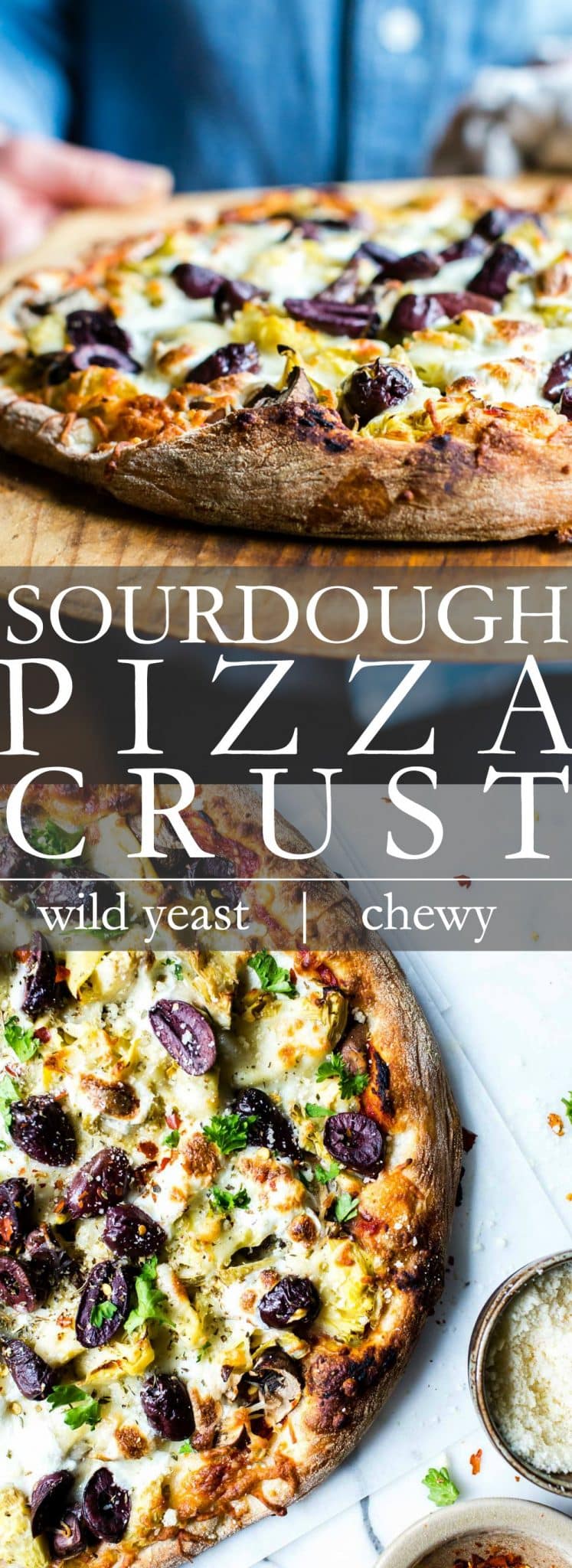
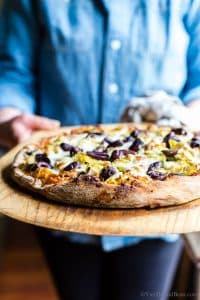
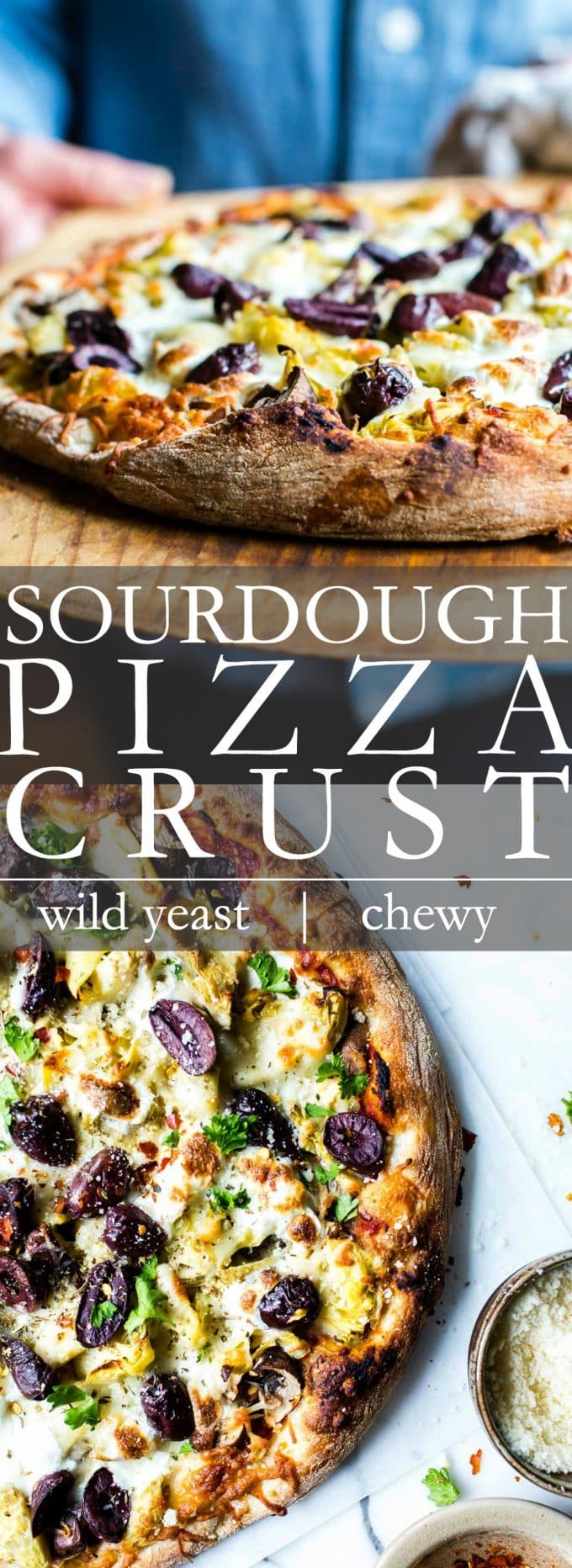
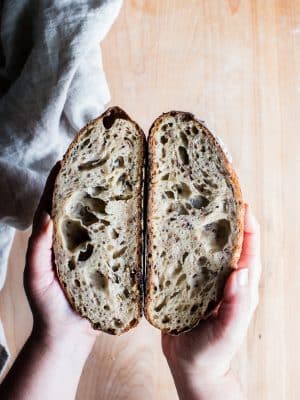



Hi! I’ve tried this recipe before and we truly enjoy it! I am making some freezer meals for my SIL as they’re getting ready to welcome a new babe! Would it be possible for me to fully make and cook this and then freeze it for them or would not recommend? Thanks!
Hi Cate! Thank you for your note. Such a sweet thing to do for your SIL! 😀 Since I’ve not tried freezing after baking, I’m not sure how the crust would hold up. If you test it, I’d love to hear if it works.
looks tasty! https://vanillaandbean.com/sourdough-pizza-crust/
Gratitude! Have made this several times this year and feel it is time to say thank you as it has become my/our go-to pizza dough recipe. Have now shared it with friends and family. Wish I could share a photo…
Hooray! Thank you SO much for your note and sharing with friends and family, Bern! SO happy to hear you’re enjoying the sourdough pizza and it’s on repeat!
Perfect! Made 2x 11”. Let the second proof go in the fridge 2 days cause, well, life. Baked on my cast iron pizza pan. Keeper!
Hooray! So happy to hear, Emily! Love the 2 day fridge rest and cast iron pan. Thank you for coming back, sharing a note and rating the recipe!
The absolute best pizza dough out there. We have made it twice and both times it was both delicious and easy to handle. Thanks for sharing.
Hooray, Santina! Thank you for coming back and sharing your thoughts. I’m super happy to hear y’all are enjoying it! Easy to handle is key :D
Hi Traci!
I’m looking forward to my first attempt at making pizza dough. I’m confident that it’ll turn out great because your recipes always hit the mark. I have one question: does this recipe make 4 – 11” pizzas or 2 – 11” pizzas?
Thank you!
Hi Camille! Thank you for your note and sending a smile. Hooray for your first attempt – SO excited! You can make four, 11″ pizzas or two, 11″ pizzas, – your choice! I wrote the ingredients for either portion on the recipe card for convenience. I usually make two for Rob and I, so we can have leftovers, but when we have guests or family over, I make four or more! Please keep in touch and let us know how you do!
Made this pizza crust for the first time and it was the tastiest crust ever! Thanks so much for this recipe!
Hooray! Thank you, Savannah, for coming back, leaving a note and rating! Here’s to more homemade pizza!
I’m sorry if someone has already asked this, I tried to scan the comments first to see.
But how long can the dough stay in the refrigerator before taking out to bake? I mixed up the dough today (Thursday), but I was hoping to use them on Saturday without freezing them, because they haven’t turned out as well like you said, after freezing.
Hi Leah… I’m glad you asked! The shaped dough will be fine in the fridge for about 48 hours, so I wouldn’t hesitate using the dough on Saturday. A reminder to mix some dough myself!
I made it and found that the dough did not cook through. Also did not have big air bubbles as I expected 😔
Hi Rose! I’m sorry to hear this recipe didn’t work for you. I’m curious about oven temperature and if the oven was hot enough. Also for big airy bubbles, look for a recipe that’s a higher hydration and doesn’t include whole wheat. Whole wheat offers an earthy flavor but it weighs down the dough. I hope this helps!
Used this recipe and made 2 pizzas, the dough was delicious…..My husband said it was his favorite so far out of all my pizza dough trials. When I first pressed the dough out to make the pizza shell, it seemed a bit thin but the end result was fantastic. I cooked the pizza in a flat cast iron, one I use for tortillas, I added a sprinkle of oil and put just the dough in the oven for about 3 min then took out and added topping. Cooking the dough first made the dough rise a bit so it was not so thin for the toppings.
Hi Bonnie! Thank you for your note and giving the pizza a go. So happy to hear your hubs loved it too :D Excellent tip about baking on a flat cast iron… I’m going to try that! If you give the dough a few pokes with the tines of a fork (dock the dough) it’ll help keep the air from pushing the pizza crust up – so you’ll have a flatter surface for your toppings. Thank you again, Bonnie!
This is my favoriet of all the sourdough crust recipes i have tried. I have used it with many different flour combos and its always greatand my official go to crust recipe
Hi Janna! Thank you for your note and giving the recipe a go. So happy to read your note!
I have tried A LOT of sourdough pizza dough recipes but this one is the very best of them all. THANK YOU! Amazingly soft chewy crust. Just perfect. Excellent instructions and easy to follow.
Hiii Melissa! Thank you for your note, rating and giving the recipe a go! So happy to hear you enjoyed the sourdough crust and that the directions were easy to follow. Here’s to delicious, homemade pizza!
My new favorite pizza crust recipe! Thank you so much.
Made a neopolitan and a white pie. Both were incredible.
Hooray Michelle! Thank you for your note and sharing your thoughts. So happy to hear! Your Neapolitan and white pie sound fabulous!
This is amazing flavorful wonderful textured dough. I have two different starters
I made a batch of dough with each .
Made home made tomato sauce
the end result delicious margherita pizza’s
Thank you
Hi Avra! SO happy to hear you enjoyed the sourdough pizzas! Thank you for your note and giving the recipe a go. What fun, two starters and a margherita pizza! Hooray!
You slice the pizza, I’ll bring the wine! Love this, my friend!!
It was perfect the first time. I learn so much from you as well! Keep it up great post.
SO happy to hear Ghulam! Thank you for your note, rating and giving the recipe a go. Here’s to homemade pizza!
Thanks so much for this recipe! My daughter is staying with us during Covid lockdown. We made the sourdough pizza crust and absolutely loved it. The directions were easy to follow and we especially loved the tip for transferring the crust to the oven using the parchment paper. It could have been a real disaster without it.
Hi Teresa! Ohhh, so happy to hear you two enjoyed the recipe and the directions were helpful. I love that you and your daughter made this together – what fun! Thank you for coming back to leave a note and rating!
Wow – love this tutorial, Traci – so much to learn here! You are rocking the sour dough lately – this pizza looks amazing – love all the toppings!
Thank you G! You’d love it… and despite ALL the guidance, it’s quite easy to make! I put way too many toppings on my pizza lol! There really should be about 1/2 of all that!
I LOVE the idea of making a sourdough pizza crust! That side shot you took of the pizza slice is dreamy… the texture of the crust looks perfect!
Thank you Sarah! It’s such a treat and especially that it’s homemade!
Great tips Traci! Thanks so much for sharing. I want to reach into my screen and grab a slice or two. That pie looks incredibly delicious!
Thank you Mare! I’d love to share a pizza with you…!
I’m with Liz…pizza is number one on my list of foods I am missing right now. I’ve never mastered the technique of shaping the pizza dough no matter how many times I’ve tried though I keep at it. Maybe with your tips I’ll get it down. Had been toying with the idea of venturing into the sourdough starter scene before your post last week. Looking at this pizza may be even more motivation to give it a go!
Hi Jean! Homemade pizza is SO good! And the process is so much fun… watching the dough change over time and figuring out your favorite toppings. YES to sourdough… if you go there, please keep in touch. I’m here for you!
Restaurant pizza (and margaritas!) is the one thing I’ve been missing the most since not going out to eat these past 2 months. Guess I need to start making it more often at home! Looks fab Traci! Love all the tips!
I SO get it Liz! That’s one thing I miss so much… going out (I’m tired of cooking – lol!)